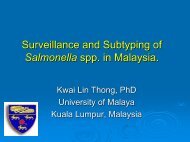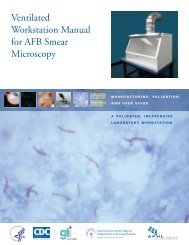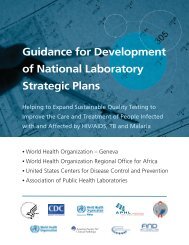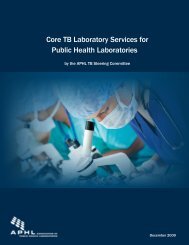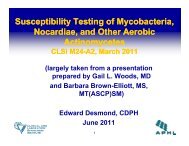Advances in Laboratory Detection of Trichomonas vaginalis
Advances in Laboratory Detection of Trichomonas vaginalis
Advances in Laboratory Detection of Trichomonas vaginalis
Create successful ePaper yourself
Turn your PDF publications into a flip-book with our unique Google optimized e-Paper software.
Diagnostic Methods<br />
The traditional diagnostic method for trichomoniasis has<br />
been wet mount with microscopic visualization <strong>of</strong> motile<br />
T. vag<strong>in</strong>alis parasites on slide preparations from vag<strong>in</strong>al<br />
or urethral secretions. Ideally, specimens should be<br />
exam<strong>in</strong>ed with<strong>in</strong> 10 m<strong>in</strong>utes to observe motile parasites,<br />
which are diagnostic. Wet mount is an <strong>in</strong>expensive<br />
diagnostic test; however, sensitivity is estimated at<br />
51-65%, and varies based on the <strong>in</strong>dividual perform<strong>in</strong>g<br />
the test and how promptly the slide is <strong>in</strong>terpreted. 8,9<br />
Culture has been considered the gold standard<br />
for diagnosis <strong>of</strong> trichomoniasis with a specificity<br />
approach<strong>in</strong>g 100%, but it is not widely used and<br />
its sensitivity can be as low as 75–96%. 8,9 Cl<strong>in</strong>ical<br />
specimens can be <strong>in</strong>oculated <strong>in</strong>to transport systems<br />
such as Amies gel medium to ma<strong>in</strong>ta<strong>in</strong> viability for up<br />
to 24 hours at room temperature. 10 Culture systems<br />
such as InPouch TV (BioMed Diagnostics, San Jose, CA)<br />
allow for direct <strong>in</strong>oculation, culture and microscopic<br />
exam<strong>in</strong>ation. Additionally, these systems can be used<br />
to transport specimens after <strong>in</strong>oculation. Such systems<br />
are useful when immediate transportation <strong>of</strong> specimens<br />
to the laboratory is not available. The specimen should<br />
be <strong>in</strong>oculated as soon as possible (with<strong>in</strong> an hour <strong>of</strong><br />
collection) to ma<strong>in</strong>ta<strong>in</strong> viability <strong>of</strong> the organism.<br />
Neither conventional nor liquid-based Papanicolau (Pap)<br />
smears are suitable for rout<strong>in</strong>e screen<strong>in</strong>g or diagnosis<br />
<strong>of</strong> T. vag<strong>in</strong>alis, because sensitivity is poor; <strong>in</strong> addition,<br />
positive predictive value is low <strong>in</strong> sett<strong>in</strong>gs where the<br />
prevalence <strong>of</strong> <strong>in</strong>fection is low. 11<br />
The OSOM (formerly Xenostrip) <strong>Trichomonas</strong> Rapid<br />
Test (Sekisui Diagnostics, Fram<strong>in</strong>gham, MA) is an<br />
immunochromatographic capillary-flow enzyme<br />
immunoassay dipstick test and the only rapid antigen<br />
test commercially available <strong>in</strong> the US. It is performed<br />
on vag<strong>in</strong>al secretions with results available with<strong>in</strong><br />
10 m<strong>in</strong>utes. This po<strong>in</strong>t-<strong>of</strong>-care test is FDA-cleared for<br />
females and CLIA waived. Test specifications <strong>in</strong>clude<br />
sensitivity 82–95% and specificity 97–100%. 8,12<br />
The Affirm VPIII Microbial Identification Test (Becton<br />
Dick<strong>in</strong>son, Frankl<strong>in</strong> Lakes, NJ) is an FDA-cleared nucleic<br />
acid probe test for the diagnosis <strong>of</strong> three causes <strong>of</strong><br />
female vag<strong>in</strong>itis: T. vag<strong>in</strong>alis, Gardnerella vag<strong>in</strong>alis and<br />
Candida albicans. Sensitivity for T. vag<strong>in</strong>alis is 63%<br />
and specificity 99.9%. 13 This is considered a same-day<br />
test as it produces results <strong>in</strong> 45 m<strong>in</strong>utes; however, it is<br />
characterized as a CLIA moderate complexity test.<br />
Nucleic acid amplification tests (NAATs) are the most<br />
sensitive tests available for detection <strong>of</strong> T. vag<strong>in</strong>alis. The<br />
APTIMA <strong>Trichomonas</strong> vag<strong>in</strong>alis Assay (Hologic Gen-Probe,<br />
San Diego, CA) was FDA-cleared <strong>in</strong> 2011 for use with<br />
ur<strong>in</strong>e, endocervical and vag<strong>in</strong>al swabs, and endocervical<br />
specimens collected <strong>in</strong> the Hologic PreserveCyt solution<br />
(Th<strong>in</strong>Prep) from females only. Sensitivity is 95–100%<br />
and specificity is also 95–100%. 8, 13, 14 The BD ProbeTec<br />
<strong>Trichomonas</strong> Vag<strong>in</strong>alis Q x Amplified DNA Assay (Becton<br />
Dick<strong>in</strong>son, Frankl<strong>in</strong> Lakes, NJ) launched <strong>in</strong> Europe (EU<br />
cleared) <strong>in</strong> 2012, but is not FDA-cleared <strong>in</strong> the United<br />
States at this time.<br />
Diagnosis <strong>of</strong> T. vag<strong>in</strong>alis <strong>in</strong> men has been challeng<strong>in</strong>g<br />
given the low sensitivity <strong>of</strong> microscopy and lack <strong>of</strong><br />
FDA clearance to date for any NAATs or po<strong>in</strong>t-<strong>of</strong>-care<br />
tests for use with male specimens. Some laboratories<br />
have verified the performance characteristics <strong>of</strong> NAATs<br />
through a validation process for male ur<strong>in</strong>e specimens<br />
or penile-meatal swabs. Culture <strong>of</strong> ur<strong>in</strong>e, semen, and/or<br />
urethral swabs may be other diagnostic options for men.<br />
Screen<strong>in</strong>g and Treatment<br />
Current recommendations for T. vag<strong>in</strong>alis test<strong>in</strong>g<br />
and screen<strong>in</strong>g, along with detailed cl<strong>in</strong>ical treatment<br />
recommendations, can be found <strong>in</strong> CDC’s STD Treatment<br />
Guidel<strong>in</strong>es, available onl<strong>in</strong>e at:<br />
http://www.cdc.gov/std/treatment<br />
2 APHL Public Health <strong>Laboratory</strong> Issues <strong>in</strong> Brief






